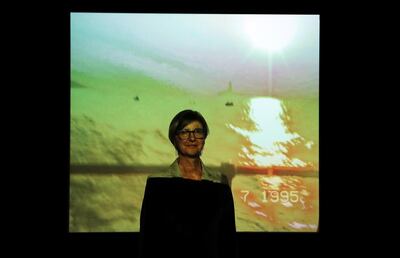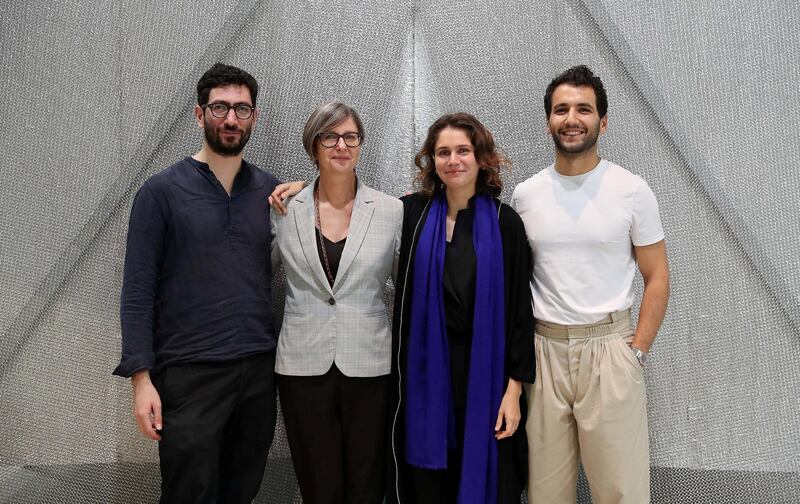Inside a cube-like installation in Abu Dhabi Art, clothed in chain-mail and illuminated so that it shines like silver, are “women’s voices”, says the artist Marysia Lewandowska. “They come seeping out of the structure, floating like a welcome.”
Lewandowska’s work is the latest instalment in her Open Cinema project, which she has been pursuing since 2012. For each of these, she investigates a country’s media archives, and works with an architecture firm to create a bespoke cinema to show a place’s history back to itself.
“I rely on archives – what exists and circulates in the country,” says the artist, a tall, bookish woman who has the wry determination of a veteran researcher. “Those archival films already say a lot about the culture before I come and edit it into something that I want to say.”
Lewandowska grew up in communist Poland, and in a way, seems not to have relinquished the fidelity to things held in common, whether it be goods or a set of ideas. In Open Cinema, which has had previous instalments in Portugal and Hong Kong, she looks to a country’s archives as a common memory.
“I am trying to build a picture of the Emirates that is not based on the official footage and which is not about the oil,” she explains. “The question is: who has access to generate those images that represent the culture? That was very crucial for me in Abu Dhabi … many of the films that you see [of the emirate] were commissioned by the government or corporations, so they had professional filmmakers or editors. That’s different to someone just having a camera. In the 1980s, the first portable camcorders appeared on the market, and to have access to that footage was my next challenge – to find people who had access to cameras for pleasure. What they generated was a very different image to the people who were commissioned to say something about this part of the world.”
Lewandowska's resulting video Cinema Island (2018) splices together home footage from a local Emirati family with images shot by British Petroleum to document their activities in the region. Shown as part of Hammad Nasar's exhibition Structures of Meaning | Architectures of Perception, within the fair, the video takes Abu Dhabi's history into something more nebulous: the slipperiness of memory and the permanence of feeling.
Stories in mother tongues
Lewandowska arrived in Abu Dhabi around a year ago, hoping to make a film out of its archives, but access was harder than she anticipated. In the end, she found two major sources: the archives of BP in London, and with the help of Dyala Nusseibeh, the fair’s director, the artist and designer Ahmed Al Areef.
“Ahmed said, yes, my father shot a lot of footage when I was little,” recalls Lewandowska. “And he was born the same year as my daughter, 1989, so I suddenly felt I would be seeing something I knew – I had been filming my own daughter at the same time.”

Al Areef generously digitised around six hours of footage, and Lewandowska placed the two sources together: the corporate story of Abu Dhabi, related to oil and economic expansion, and the more personal history of the family growing up here. Footage shows a father allowing himself to be tackled by his kids, the family’s young boys watching the spray come up against rocks in Oman, or horsing around with snowballs in Pakistan.
“There are beautiful displays of tenderness between father and sons,” she says. “The amount of physical embrace is almost surprising. They’re not paying any attention to the camera – it’s completely genuine. In my experience of seeing a lot of home videos, you rarely see men with such tenderness, and so relaxed.”
There are no women in the film, at the request of the family, creating a gender split which Lewandowska addressed by separating the film into sound and image. “When I came here to research I met a lot of people in a lot of cultural institutions, and they were all women. So I went back to those women and asked them to record a story in their mother’s tongue.” She used these stories for the video’s soundtrack.
Nusseibeh herself opens the video, with lines from Ali Baba. The artist Hind Mezaina tells the story of Sinbad, and songs are sung.
Part of the joy of this video becomes the sheer beauty of the Arabic language: at points it dissociates from the footage and takes over the work. One of the songs has a rising and falling that eclipses the histories on show and brings a more general sense of heartbreak and loss: the video shows time that no one will ever regain.
'Amateur footage is about love'
The oldest footage in the film is from 1953: images of divers dredging the ocean bed in search of oil. Improbably, the images were taken by French filmmaker Louis Malle, whose movies My Dinner with Andre and Au Revoir les Enfants were international hits in the 1980s.
_________________
Read more:
Everything you need to know about what's on show at this year's Abu Dhabi Art
Maitha Abdalla: the artist telling dark, Surrealist tales with a Khaleeji twist
Looking at Arab and Islamic design in today's modern world
_________________
The footage from BP goes by almost too fast: its story is familiar, from the wide-angle shots of areesh houses on Abu Dhabi island to the rapidly constructed concrete towers that are now beginning to disappear. They function almost as a scene-setter, hurried through on the way to the images of people’s actual lives. “The private footage is just people enjoying a day out on a holiday, making sure all the members of the family are included,” Lewandowska says. “The whole subconscious of a culture is in amateur footage.
“Amateur footage, as the name tells you, is about love. That is what my project ended up being about – the tenderness that exists in the culture; in my experience of having met people here; having been hosted here. The BP footage does not give that much space.”
Lewandowska used glitches from the BP footage as markers between the five chapters of the video, which are each overlaid with a different story. The film’s construction had the setting of the art fair in mind: people can wander in and out of the 20-minute work, without feeling like they have to watch the whole thing. Tellingly, there are no seats in this cinema. The structure was designed by Aram Mooradian, Summer Islam and George Massoud of the London-based MMI Architects. The firm used chain-link silver to incorporate the method of hanging and hooking that is key in putting a temporary structure together, while also referencing the famous “silver screen” of the cinema.
The structure is as much a part of the total work as the video. “Cinemas negotiate the space between public and private, bringing this private footage to a public exhibition,” Lewandowska says. “The camera is a powerful tool, but cinema is too.”
Cinema Island is on show at Manarat Al Saadiyat until January 26






